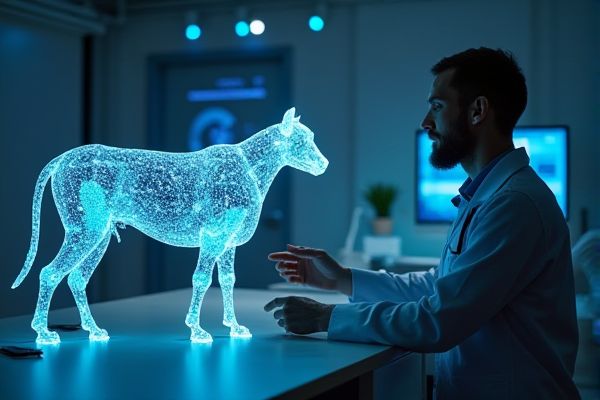
AI enhances diagnostic accuracy in veterinary medicine, enabling faster and more precise identification of diseases in animals. Machine learning algorithms analyze medical imaging, such as X-rays and MRIs, detecting anomalies that may go unnoticed by human eyes. Telemedicine applications allow veterinarians to consult with pet owners remotely, improving accessibility to care and expediting treatment decisions. Predictive analytics help in anticipating health trends, allowing for preventative measures to be implemented before issues arise.
AI usage in veterinary science
Predictive diagnostics
AI can enhance predictive diagnostics in veterinary science by analyzing large datasets to identify patterns and potential health issues in animals. For example, machine learning algorithms can assess historical health data and genetic information to predict the likelihood of diseases in breeds, such as Golden Retrievers being prone to specific cancers. This predictive capability could lead to earlier interventions, improving treatment outcomes and animal welfare. Ultimately, harnessing AI technology in veterinary practices may provide veterinarians with more accurate tools for diagnostics and decision-making.
Automated imaging analysis
Automated imaging analysis in veterinary science offers the potential to improve diagnostic accuracy and efficiency in evaluating animal health. By analyzing medical images such as X-rays and MRIs, AI can assist veterinarians in detecting conditions like fractures or tumors more effectively. The integration of AI tools can lead to faster decision-making, which might enhance treatment outcomes for patients. Institutions like the University of Pennsylvania have begun exploring these technologies, showcasing their promise in advancing veterinary care.
Personalized treatment plans
AI in veterinary science can enhance the creation of personalized treatment plans for pets. By analyzing data from various sources, such as veterinary records and diagnostics, AI can identify specific health issues and recommend tailored interventions. Institutions like the American Veterinary Medical Association are exploring these advancements to improve patient outcomes. This technology has the potential to increase the effectiveness of treatments and enhance the overall quality of care for animals.
Disease surveillance
AI can enhance disease surveillance in veterinary science by analyzing large sets of data to identify patterns in animal health. By monitoring data from sources like veterinary clinics or agricultural institutions, AI can predict outbreaks and improve response times. Implementing AI tools may lead to more accurate diagnoses, benefiting practices such as veterinary diagnostics. The adoption of AI can ultimately foster better overall outcomes for animal health management.
Remote monitoring
AI usage in veterinary science offers the possibility of enhancing remote monitoring of animal health. By analyzing data from wearable devices, veterinarians can track vital signs and behavior patterns, leading to timely interventions. For instance, a system like Vet Guardian could alert pet owners about potential health issues before they become serious. This proactive approach may improve treatment outcomes and reduce veterinary costs in the long run.
Genetic research enhancement
AI applications in veterinary science can significantly enhance genetic research by analyzing large datasets efficiently. This technology allows for the identification of genetic markers associated with specific diseases in animals, improving breeding practices. Institutions like the University of California, Davis, are exploring these advancements to better understand animal health. Such efforts may lead to more effective treatment options and improved animal welfare.
Behavioral analysis
AI can significantly enhance behavioral analysis in veterinary science by providing precise insights into animal behavior patterns. Tools like machine learning algorithms can analyze data from various sources, such as wearable sensors, to identify stress indicators in pets. For example, institutions like the University of Edinburgh are exploring AI applications to improve animal welfare. The potential to predict behavioral issues could lead to better treatment options and preventive care for pets.
Resource management optimization
AI can enhance resource management in veterinary science by improving scheduling and allocation of staff and equipment. For example, a veterinary clinic may use AI algorithms to predict the demand for specific services, allowing for better staffing decisions. This optimization can lead to reduced wait times for patients and increased overall efficiency. The chance of improved patient outcomes increases as resources are allocated more effectively.
Smart prosthetics development
AI in veterinary science can enhance diagnostics by analyzing medical imaging more accurately than traditional methods. Smart prosthetics development for animals can lead to improved mobility and quality of life for pets recovering from injuries. Institutions like the University of California, Davis, are exploring the integration of these technologies to provide better care for animals. The possibility of combining AI and smart prosthetics can create tailored solutions that significantly benefit both animal health and rehabilitation processes.
Client communication improvement
AI tools can enhance client communication in veterinary science by providing real-time insights into pet health. For example, a veterinary clinic may use an AI-driven platform to analyze patient data and deliver personalized health updates. This can lead to improved client engagement and satisfaction, fostering a better relationship between pet owners and veterinarians. Leveraging AI can also streamline appointment scheduling and follow-up reminders, maximizing operational efficiency.
 techknowy.com
techknowy.com